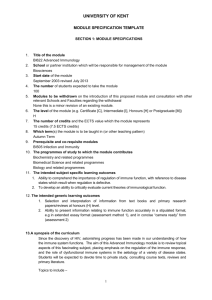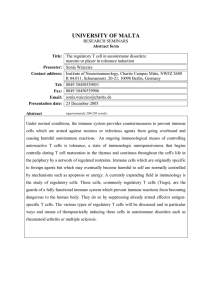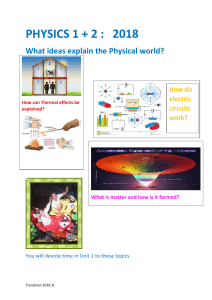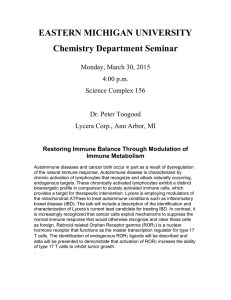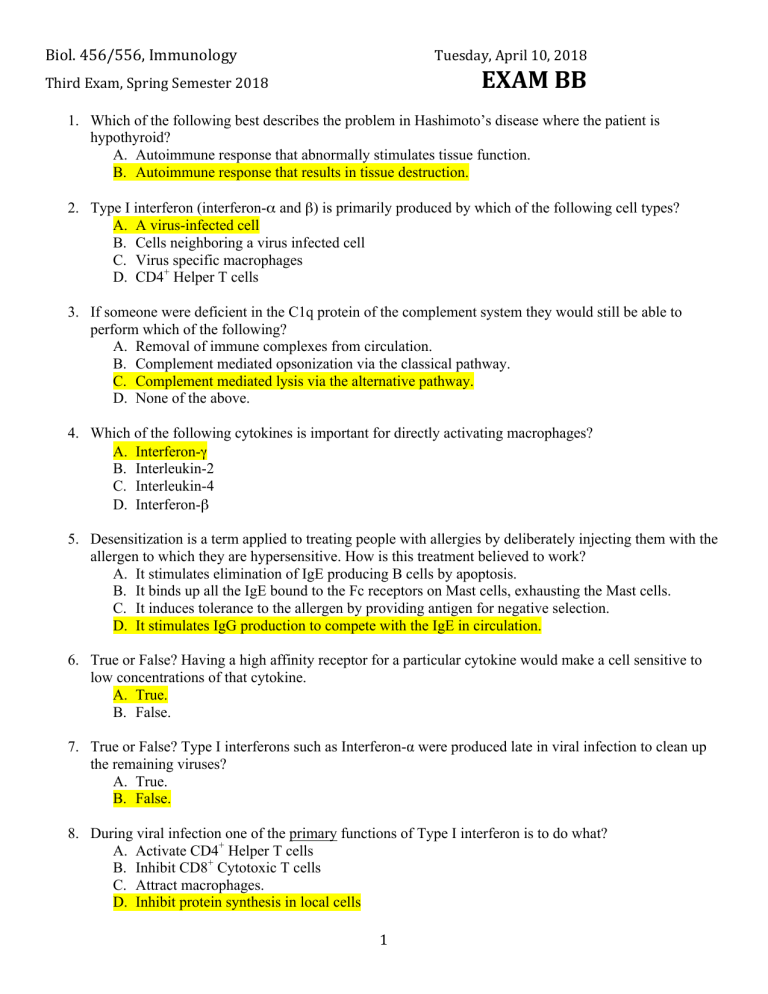
Biol. 456/556, Immunology Tuesday, April 10, 2018 EXAM BB Third Exam, Spring Semester 2018 1. Which of the following best describes the problem in Hashimoto’s disease where the patient is hypothyroid? A. Autoimmune response that abnormally stimulates tissue function. B. Autoimmune response that results in tissue destruction. 2. Type I interferon (interferon-α and β) is primarily produced by which of the following cell types? A. A virus-infected cell B. Cells neighboring a virus infected cell C. Virus specific macrophages D. CD4+ Helper T cells 3. If someone were deficient in the C1q protein of the complement system they would still be able to perform which of the following? A. Removal of immune complexes from circulation. B. Complement mediated opsonization via the classical pathway. C. Complement mediated lysis via the alternative pathway. D. None of the above. 4. Which of the following cytokines is important for directly activating macrophages? A. Interferon-γ B. Interleukin-2 C. Interleukin-4 D. Interferon-β 5. Desensitization is a term applied to treating people with allergies by deliberately injecting them with the allergen to which they are hypersensitive. How is this treatment believed to work? A. It stimulates elimination of IgE producing B cells by apoptosis. B. It binds up all the IgE bound to the Fc receptors on Mast cells, exhausting the Mast cells. C. It induces tolerance to the allergen by providing antigen for negative selection. D. It stimulates IgG production to compete with the IgE in circulation. 6. True or False? Having a high affinity receptor for a particular cytokine would make a cell sensitive to low concentrations of that cytokine. A. True. B. False. 7. True or False? Type I interferons such as Interferon-α were produced late in viral infection to clean up the remaining viruses? A. True. B. False. 8. During viral infection one of the primary functions of Type I interferon is to do what? A. Activate CD4+ Helper T cells B. Inhibit CD8+ Cytotoxic T cells C. Attract macrophages. D. Inhibit protein synthesis in local cells 1 Biol. 456/556, Immunology Tuesday, April 10, 2018 EXAM BB Third Exam, Spring Semester 2018 9. The transcription factor NFκB in mammalian cells is analogous to which molecule in the fruit fly's immune system? A. Toll B. Cactus C. Dorsal immune factor D. Spätzle 10. Which of the following cytokines is associated with inducing fever? A. Interleukin-1. B. Interleukin-2. C. Interleukin-5. D. Interleukin-10. 11. Perforin released from the granules of NK and cytotoxic T cells is most similar to which of the following other molecules in the immune system? A. Interleukin-2. B. C9. C. Fas. D. FasL. 12. A woman who is Rh+ has a first child with a man who is Rh-. What, if any, are the likely consequences if the woman has a second child with the same man? A. No problem expected. B. The second child is at risk to develop myasthenia gravis. C. The mother will develop hemolytic anemia. D. The second child has at least a 50% chance of developing hemolytic anemia of the newborn. 13. A woman who is Rh- has a first child with a man who is Rh+. What, if any, are the likely consequences if the woman has a second child with the same man? A. No problem expected. B. The second child is at risk to develop myasthenia gravis. C. The mother will develop hemolytic anemia. D. The second child has at least a 50% chance of developing hemolytic anemia of the newborn. 14. Antibody dependent cellular cytotoxicity is a mechanism used by Natural Killer cells to recognize which cells should be killed. This recognition is dependent on which of the following? A. Absence of MHC class I molecules on the surface of the target cells. B. Absence of Fc receptors on the surface of the target cells. C. Presence of antibodies bound to the surface of the target cells. D. Presence of FasL on the surface of the target cell. 15. CD25 is the high affinity form of the Interleukin-2 receptor. Which of the following characteristics does CD25 provide a T cell? A. Sensitivity to low concentrations of Interleukin-2. B. Sensitivity to high concentrations of Interleukin-2. C. A bias towards becoming a regulatory T cell. D. A bias towards becoming a TH2 cell. 2 Biol. 456/556, Immunology Tuesday, April 10, 2018 EXAM BB Third Exam, Spring Semester 2018 16. Which one of the following autoimmune diseases most resembles a type IV hypersensitivity? A. Grave’s Disease. B. Myasthenia Gravis. C. Multiple Sclerosis. D. Systemic Lupus Erythematosis. 17. Multiple sclerosis is an example of which of the following types of autoimmune disease? A. Systemic. B. Organ specific. 18. Granzymes released from the granules of cytoxic T cells contribute to the death of a virus infected cell by doing what? A. Punching holes in the target cell membrane. B. Activating the complement pathway. C. Activating the apoptotic pathway. D. Binding to Fas. 19. Macrophage activation is associated with which of the following? A. Increased metabolic activity. B. Increased antigen presentation. C. Increased expression of MHC class II proteins. D. All of the above. 20. A patient is suffering from being unable to clear a chronic infection. You isolate peripheral blood CD4+ T cells from this patient and discover they are primarily making Interleukin-2 and Interferon-γ. Based on these observations, which of the following immune mechanisms are most likely to be successful in clearing this infection? A. Stronger antibody response. B. More activation of macrophages. C. Cytotoxic T cells. D. Regulatory T cells. 21. Why is DNA rich in the dinucleotide CpG a good indicator of an infection? A. All life on this planet uses DNA as its genetic material. B. During tissue damage our cells release CpG due to apoptosis. C. Human DNA is underrepresented in CpG. D. CpG DNA cleaves pro-Spätzle into Spätzle. 22. Why are self-molecules such as fibronectin and heat shock proteins recognized by the immune system as “danger” signals? A. They are produced by Mast cells in during degranulation. B. They are indicators of tissue damage. C. They are also produced by pathogens in an attempt to mimic self and hide from the immune system. D. They prevent autoimmune responses 3 Biol. 456/556, Immunology Tuesday, April 10, 2018 Third Exam, Spring Semester 2018 EXAM BB 23. Which of the following differ between a Type I and Type II hypersensitivity? A. The isotype of antibody involved. B. The dependence on antibodies. C. Pre-existing exposure to antigen. D. Activation of TH2 type helper T cells. 24. True or False? Failure to express MHC class II molecules results in a cell being a target for killing by NK cells. A. True B. False 25. In fruit flies, the toll receptors bind which of the following? A. Microbial components. B. Viral components. C. Spätzle. D. All of the above. 26. A camper walks through a patch of plants that has three leaf clusters. They've walked through these plants at least once before with no problems so thought nothing of it. But 24 to 48 hours they develop a severe rash on their legs with red, swollen bumps. Which of the following mechanisms are at work in their skin? A. Natural Killer cells are trying to kill local cells to shed the swollen areas. B. IgE is activating macrophages to release their histamine and cause vaso-dilation. C. Cytotoxic T cells are producing interferon-γ to stimulate Fas production. D. TH1 type T cells are producing interferon-γ, attracting and activating local macrophages. 27. Human mutations in the FoxP3 gene are often associated with diverse forms of autoimmune disease. What is the likely mechanism for why FoxP3 deficiency results in autoimmunity? A. FoxP3 deficiency results in increased TH17 cell production. B. FoxP3 deficiency results in breakdown of negative selection of B cells during development. C. FoxP3 deficiency results in breakdown of peripheral tolerance. D. FoxP3 deficiency results in breakdown of central tolerance. 28. Interleukin-4 is associated with which of the following characteristics? A. A T cell growth factor. B. A B cell growth factor. C. Activation of macrophages. D. Suppressing TH2 responses. 29. Which of the following molecules secreted by Mast cells will increase vascular permeability? A. Histamine. B. Serotonin. C. Leukotrienes. D. All of the above. 4 Biol. 456/556, Immunology Tuesday, April 10, 2018 EXAM BB Third Exam, Spring Semester 2018 30. Which combinations of cytokines most influence whether at CD4+ T cell becomes a TH1 or TH2? A. IL-4 and IL-5. B. IL-2 and IFN-γ. C. IL-4 and IL-12. D. IL-17 and IFN-β. 31. Which of the following is only used in the classical complement pathway? A. C1 B. C5 C. C7 D. C9 32. The presence of IgG bound to the surface of an antigen will cause what response from B cells? A. Increased activation. B. Switching to make a different isotype. C. Decreased activation. D. Tolerance to the antigen. 33. A transfusion reaction due to being given the wrong blood type is which of the following types of hypersensitivity reactions? A. Type I hypersensitivity. B. Type II hypersensitivity. C. Type III hypersensitivity. D. Type IV hypersensitivity. 34. Formation of immune complexes due to high levels of pre-existing antibody is associated with which of the following hypersensitivities? A. Type I. B. Type II. C. Type III. D. Type IV. 35. A toll like receptor (TLR) that binds to a molecule found on the surface of a pathogen is likely to be found where on a phagocytic cell? A. In the nucleus. B. In a lysosome. C. In the endoplasmic reticulum. D. On the cell surface. 36. The Membrane Attack Complex of the complement system does which of the following? A. Forms a pore in the membrane of cells. B. Opsonizes antigens. C. Regulates B cell activation. D. Attracts other cells to the site of infection. 5 Biol. 456/556, Immunology Tuesday, April 10, 2018 EXAM BB Third Exam, Spring Semester 2018 37. Removal of immune complexes from circulation is associated with which of the following complement pathways? A. Alternative. B. Classical. C. Lectin. 38. Oral tolerance refers to what phenomenon? A. Elimination of T cells that react with food antigens during thymic negative selection. B. The stimulation of the symptoms of multiple sclerosis in patients fed myelin basic protein. C. Loss of responsiveness to antigens ingested. D. Immunologists only say nice things about other people. 39. Which of the following is the best definition of an interleukin? A. Soluble molecules produced by one white blood cell type that influences other white blood cell types. B. Activators of the alternative pathway of Complement. C. Soluble factors that opsonize antigen. D. A risk factor for developing autoimmune disease. 40. True or False? Regulatory T cells are selected in the thymus for their absence of binding affinity for selfantigens. A. True. B. False. 41. Human toll like receptors (TLRs) are receptors for which of the following kinds of molecules? A. Microbial components. B. Endogenous stress related molecules. C. Viral components. D. All of the above. 42. Which of following is a good definition of anaphylatoxins? A. Another name for a superantigen such as Staph enterotoxins. B. Complement component cleavage products that activate Mast cell degranulation. C. Caspases that contribute to apotosis. D. Cytokines produce by Natural Killer cells. 43. Which of the following is a common component of all four types of the hypersensitivities? A. They are all antibody mediated. B. They all depend on the release of histamine. C. They all require prior exposure to the antigen. D. All of the above. 6 Biol. 456/556, Immunology Tuesday, April 10, 2018 EXAM BB Third Exam, Spring Semester 2018 44. The lectin pathway of complement activation relies on mannose binding lectin (MBL) as a recognition molecule. Why is this a good mechanism for clearing pathogens? A. Virus infected cells have the sugar mannose on their surface. B. Mannose is associated with bacterial cell walls. C. MBL binds the Fc region of IgG, which is glycosylated with mannose. D. Phagocytic cells have Fc receptors that directly bind MBL. 45. More than a century ago, Almroth Wright demonstrated that the presence of immune serum enhanced phagocytosis and called it opsonization. Based on what we now know which of the following molecules help explain the opsonization phenomenon? A. Toll like receptors. B. β2-microglobulin. C. Fc receptors. D. The high affinity IL-2 receptor. 46. Which of the following can occur by only the covalent attachment of C3b to the surface of a bacterial cell? A. Opsonization of the bacterial cell. B. Activation of the remainder of the classical Complement pathway leading to lysis of the bacteria. 47. Production of Interleukin-4 will result in a bias of CD4+ T cells towards which type of activity? A. TH1. B. TH2. C. TREG. D. TH17. 48. Which of the following cytokines is associated with inhibiting immune responses? A. Interleukin-2. B. Interleukin-5. C. Interleukin-10. D. Interleukin-17. 49. Which of the following best describes the problem in Type I diabetes? A. Autoimmune response that abnormally stimulates tissue function. B. Autoimmune response that results in tissue destruction. 50. Which of the following are diagnostic for Systemic Lupus Erythematosis? A. IgE specific for red blood cells. B. TH1 type T cells specific for myelin basic protein. C. Anti-nuclear antibodies. D. Mutations in the Sry gene. 7


